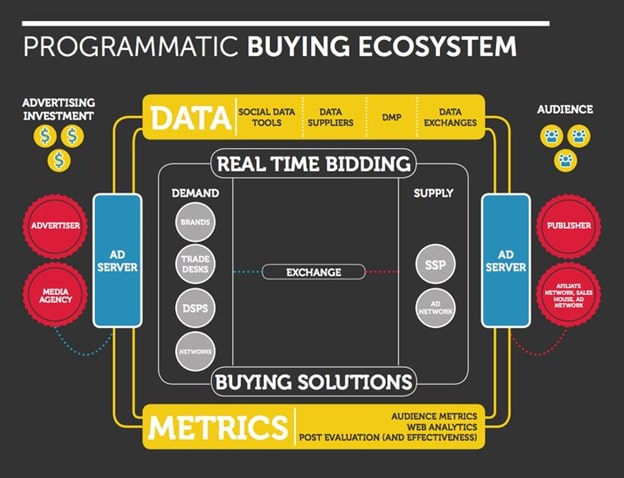Programmatic Video Advertising
Back in the old days, companies used to buy ad space by speaking to other humans. Media buyers would get inventory and negotiate ad placement by contacting multiple companies.
Then came machine learning and data hence the whole thing changed. Today, appx 75% of video ads are programmatic. What does that mean?
Programmatic video advertising refers to the practice of using bots to buy ad space based on certain parameters. The advertiser, define your ideal audience in detail, provide access to your ads, and set a budget.
The program takes that user data and uses real-time bidding to display your ad to a user that fits your ideal client profile. As with Google PPC ads, the ad with the highest bid wins. The whole thing happens in the time it takes to load a page.
Theoretically, this is a hyper-effective move. Machines are more efficient at communicating with each other and using the data you give them to get your ad in front of the right person. Plus, improved targeting should help you increase your conversion rates and lower the cost per acquisition because you are only going after interested parties.
So it’s no wonder that programmatic video advertising is growing, mostly driven by YouTube’s TrueView ads and better internet loading speeds that allow for quality browser video ads.
Why is programmatic video advertising useful?
Running targeted ads that only show up in front of people interested in what you’ve got to offer sounds like a marketer’s dream. Let’s take a look at what makes programmatic video advertising useful.
Excellent reasons to go programmatic
Reach a super-specific audience
Traditionally you had the option of buying ad space in a popular time slot on TV or on a site your audience may frequent. Programmatic advertising uses behavioral data to find your audience and display the perfect video ad, making it much more effective.
Cross-channel reach
Because programmatic advertising relies on data, it allows us to reach across channels and serve targeted ads on mobile, desktop, and even TV sets.
Easy to tweak campaigns
You can make adjustments to the info you’ve provided and change the parameters of ad buying altogether. It’s quick and easy, and doesn’t involve lengthy meetings or re-negotiations.
No need for IRL deal making
Programmatic media buying lets the algorithms do all the work. You don’t need to painstakingly build direct relationships with buyers and sales teams. You just need to give the algorithms enough info to be able to make snap data-based decisions.
Quantitative reporting
All media ad space reports are based on data and communications between machines. There’s no guesswork here and you can use the data to find out just how successful your ads are and then improve them.
It’s not all sunshine and algorithms
Like all good things, programmatic video advertising comes with some challenges.
Ad fraud
There’s an old rule on the internet — if it’s online, someone will try to hack it. Bots can be used to fool the system and artificially drive prices up, resulting in a higher spend. However, as the tech gets more sophisticated, we’ll see more safety measures put in place.
Potential loss of granularity
If you’re using an ad network, you might not have exact control of where your ad is shown. This can be a challenge with ad networks, so if you use one, pick a network with a diverse portfolio and define your audience well.
Less personal
Wait, isn’t this a contradiction!? The whole point of programmatic buying is to reach a super targeted audience.
Sure, certain algorithms focus on the bid price to help you reach a wider audience, but defining the parameters of your campaign will help you avoid reaching the wrong people.
Rely on third-party metrics
This is a common problem with third-party apps. Make sure you know how the service you use collects data, because you could be getting a skewed view of the market and your ads’ performance.
Types of video ads
We looked at the good and the challenging aspects of using programmatic advertising. Now it’s time to meet the three types of programmatic video ads.
In-stream
|
Out-stream
|
In Display

In-display ads appear at the top of your YouTube feed (that’s the ‘Up next’ column to the right of the video if you’re watching on desktop displays). Unlike in-stream and out-stream ads, they don’t autoplay. You’ve got to make an active choice to click them and find out what the ad is all about.








